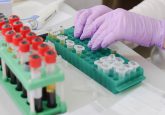Gyrolab technology – a must-have in biotherapeutics development and manufacturing

John Chappell has over 25 years of experience in the Contract Research industry supporting both preclinical and clinical drug development. He has specialized in supporting biological compounds from an analytical perspective e.g. pharmacokinetic, immunogenicity and biomarker analysis. He is particularly interested in validation requirements and ensuring that data generated will be acceptable to the regulatory authorities.
John has spoken at many international conferences on various topics including oligonucleotide analysis, biomarker analysis, immunogenicity and the analytical support of biosimilar programs. He now leads the Application Support and Service teams for Gyros Protein Technologies (Uppsala, Sweden) where he is responsible for customer service and technical support in Europe and the Asia Pacific regions. John has been a user of Gyrolab system for over 10 years and is using this experience to help customers. He is a Fellow of the Royal Society of Chemistry and is involved in the American Association of Pharmaceutical Scientists (AAPS) Biosimilar Committee that has prepared papers on pharmacokinetic and anti-drug antibody assays.
Launched in 2003, Gyrolab® workstation was developed for parallel processing of assays such as ligand binding assays (LBA) in a miniaturized format that would require small reagent and sample volumes, and minimum hands-on time. As the technology evolved, users soon appreciated the many benefits of miniaturized immunoassays. These include the generation of data with high precision and accuracy over a broad dynamic range, minimal matrix interference, and short assay development time compared to other LBAs such as ELISA [1,2]. The broad dynamic range, for example, means fewer sample dilutions, which reduces analyst time at the bench, reagent consumption and errors introduced during sample preparation. Sixteen years later, headed by Gyrolab xPand, Gyrolab systems have become well-established workhorses that run a wide range of applications in all the major pharmaceutical companies and CROs around the world, with more than 40% of the companies having multiple systems.
Pharmacokinetics (PK) of biotherapeutics became a key application for Gyrolab system early on. The ability to handle small samples was in step with the development of microsampling of laboratory animals, which has become a significant force in the 3Rs (replace, reduce, refine) effort to minimize animal use in toxicological and pharmacological testing [3]. For example, Joyce and colleagues used Gyrolab system to validate the approach of serial microsampling (10 μL) from one mouse through LBA-based quantification of dosed biotherapeutic in diluted whole blood to derive a PK profile, resulting in the concept of ‘one mouse, one PK’ [4]. They concluded that mouse serial sampling is a very valuable method particularly with limited drug supply or specialized animal models. Overall the efficiencies gained by serial sampling resulted in 40–80% savings in study cost, animal usage, study length and drug conservation while inter-subject variability across PK parameters was less than 30%. For example, microsampling enabled the generation of nine data points each from four individual mice, in contrast to conventional sampling that generated only two data points each from 20 mice. This approach has helped companies such as AstraZeneca to make massive savings in preclinical testing and also improve data quality. The ability to handle small volumes of rare matrices has also helped others in the analysis of, for example, synovial fluid, pediatric and geriatric samples.
Making the transition into clinical studies
The success of Gyrolab analysis in preclinical PK paved the way to implementing the technology in clinical studies, primarily those involving antibody-based biotherapeutics. This included Phase I trials on biotherapeutics directed at asthma [5], Crohn’s disease [6], lung cancer [7], and antibody-peptide fusions for the treatment of diabetes [8]. Phase II trial applications include antibodies to treat breast cancer [9], and an evaluation of a biosimilar in comparison to a reference product aimed at treating rheumatoid arthritis [10]. Gyrolab PK assays were also used to confirm the performance of the first biosimilar of infliximab, CT-P13, which has been approved for use in inflammatory bowel disease by both the EMA and FDA [11]. This study also employed Gyrolab system to study the development of neutralizing antibodies against the drug product [12]. As a result of this acceptance, Gyrolab systems are now a key player in regulated bioanalysis [13].
Matrix tolerance saves PK analysis in a Phase III clinical trial
The flow-through technology of Gyrolab Bioaffy CDs results in minimal contact times and high tolerance to matrix interference that can be critical in preclinical and clinical trials that involve analysis of a range of matrices of varying complexity. An assay development group at Genentech experienced this the hard way. Their PK ELISA used in Phase I/II trials of etrolizumab in normal human and ulcerative colitis (UC) sera showed matrix interference after adding samples from patients with Crohn’s disease (CD) in a Phase III trial [14]. Efforts to improve the ELISA failed, and indications that incubation time was a critical factor led the development team to turn to Gyrolab technology. This step resulted in effective removal of the matrix effect, with the Gyrolab method showing good correlation with ELISA data in the original UC samples, giving the team confidence to move forward and use Gyrolab systems to complete the Phase III trials on both UC and CD samples.
The matrix tolerance of flow-through immunoassays run in Gyrolab Bioaffy CDs results in low minimal required dilutions (MRD) that increase assay sensitivity, which can be critical when determining the level of analytes in rare and complex matrices, such as ocular samples. Low MRDs also reduce the risk of disturbing the equilibrium between bound and free analytes.
Gyrolab robustness supports singlicate analysis
Singlicate analysis is a standard procedure for automated immunoassay analyzers used in clinical chemistry. Immunoassays, however, have historically been performed in duplicate to reduce the risk of error, but improvements in assay reagents as well as automation mean that singlicate analysis is now possible. Since Gyrolab systems are fully automated they are very suited for singlicate analysis using LBAs and, with this in mind, a group of scientists at Pfizer determined the reliability of Gyrolab assays in a retrospective study of over 23,000 replicate pairs comprising standards, QCs, and animal samples using 23 assays [15]. They concluded that “singlet versus duplicate measurements yielded nearly indistinguishable results with respect to PK parameters”, pointing out the value of Gyrolab Viewer software as a unique quality control and troubleshooting tool for Gyrolab assays that is invaluable when examining potentially aberrant results.
This study was followed up by a group at Bristol-Myers Squibb who used three Gyrolab assays and singlicates to study a biotherapeutic through three development stages: discovery (PK/TK), GLP-toxicology, both in cynomolgus monkey, and the clinical phase [16]. The high robustness of Gyrolab assays meant that the team could run samples and QCs in singlicate. While many may still feel uncomfortable with singlicate analysis, this team’s excellent results led them to state that, “In the fast-paced world of drug development where ’speed to patient’ is key, we believe that this approach bears negligible risk and can significantly increase benefit to the physicians and patients.”
The US FDA currently indicates that duplicate analysis improves accuracy and precision but only recommends duplicate analysis for calibrator samples and quality control samples. In contrast, the European Medicine Agency guideline recommends the analysis of calibrators, quality control and study samples at least in duplicate. Singlicate analysis in LBA has, however, been supported by published data and presentations from conferences and workshops in the last few years [17], and many pharmaceutical companies are now submitting singlicate data for regulatory approval. There is clearly a paradigm shift towards the acceptance of singlicate analysis using robust analytical platforms such as Gyrolab system, providing it is backed by appropriate validation.
Spinning into the future
Continuous product development and user innovation means that Gyrolab assays are being developed for a rapidly expanding range of applications, including the measurement of biomarkers, anti-drug antibody (ADA) detection, and determining levels of impurities such as protein A and host-cell proteins (HCP) in bioprocess development and manufacturing. New software enables the determination of affinity of picomolar-KD ligands that will benefit the development of effective biotherapeutics. Gyrolab systems are being used to measure titers in vaccine development and in cell and gene therapy, for example to determine the immunogenicity of viral vectors. These are just some examples of how Gyrolab systems have become established as reliable delivers of robust LBA data.
References
-
Mora JR, Obenauer-Kutner L & Patel VV. Application of the Gyrolab™ platform to ligand-binding assays: a user’s perspective. Bioanalysis, 2(10), 1711–5 (2010).
- Roman J, Qui J, Dornadula G, Hamuro L, Bakhtiar R & Verch T. Application of miniaturized immunoassays to discovery pharmacokinetic bioanalysis. J. Pharmacol. Toxicol. Methods, 63(3), 227–35 (2011).
- Törnqvist E, Annas A, Granath B, Jalkesten E, Cotgreave I & Öberg M. Strategic focus on 3R principles reveals major reductions in the use of animals in pharmaceutical toxicity testing. PLoS One, 9(7):e101638 (2014).
- Joyce AP, Wang M, Lawrence-Henderson R et al. One mouse, one pharmacokinetic profile: quantitative whole blood serial sampling for biotherapeutics. Pharm. Res. 31(7), 1823–33 (2014).
- Singh D, Kane B, Molfino NA, Faggioni R, Roskos L & Woodcock A. A phase 1 study evaluating the pharmacokinetics, safety and tolerability of repeat dosing with a human IL-13 antibody (CAT-354) in subjects with asthma. BMC Pulm. Med. 10:3 (2010).
- van der Woude CJ, Stokkers P, van Bodegraven AA et al. Phase I, double-blind, randomized, placebo-controlled, dose-escalation study of NI-0401 (a fully human anti-CD3 monoclonal antibody) in patients with moderate to severe active Crohn’s disease. Inflamm. Bowel Dis. 16(10), 1708–16 (2010).
- Gulley JL, Rajan A, Spigel DR et al. Avelumab for patients with previously treated metastatic or recurrent non-small-cell lung cancer (JAVELIN Solid Tumor): dose-expansion cohort of a multicentre, open-label, phase 1b trial. Lancet Oncol. 18(5), 599–610 (2017).
- Jain M, Carlson G, Cook W et al. Randomised, phase 1, dose-finding study of MEDI4166, a PCSK9 antibody and GLP-1 analogue fusion molecule, in overweight or obese patients with type 2 diabetes mellitus. Diabetologia. 62(3), 373–386 (2019).
- Stebbing J, Baranau Y, Baryash V et al. CT-P6 compared with reference trastuzumab for HER2-positive breast cancer: a randomised, double-blind, active-controlled, phase 3 equivalence trial. Lancet Oncol. 18(7), 917–928 (2017).
- Matsuno H, Tomomitsu M, Hagino A, Shin S, Lee J & Song YW. Phase III, multicentre, double-blind, randomised, parallel-group study to evaluate the similarities between LBEC0101 and etanercept reference product in terms of efficacy and safety in patients with active rheumatoid arthritis inadequately responding to methotrexate. Ann. Rheum. Dis. 77(4), 488–494 (2018).
- Gabbani T, Deiana S & Annese V. CT-P13: design, development, and place in therapy. Drug Des. Devel. Ther. 11, 1653–1661. (2017).
- Braun J. Response to: ‘Infliximab and CT-P13 immunogenicity assessment in PLANETAS and PLANETRA main and extension studies: utility of laboratory methods description’ by Francesca Meacci et al. Ann. Rheum. Dis. 75(10):e63 (2016).
- Ligand binding assays in the regulated bioanalytical laboratory. in Regulated Bioanalysis: Fundamentals and Practice, AAPS Advances in the Pharmaceutical Sciences Series 26. (2017).
- Williams K, Erickson R & Fischer SK. Overcoming disease-specific matrix effect in a clinical pharmacokinetic assay using a microfluidic immunoassay technology. Bioanalysis, 9(16), 1207–1216. (2017).
- Clark TH, Yates PD & Chunyk AG. Feasibility of singlet analysis for ligand binding assays: a retrospective examination of data generated using the Gyrolab platform. AAPS J. 18(5), 1300–8 (2016).
- Jiang H, Kozhich A & Cummings J. Singlicate ligand binding assay using an automated microfluidic system: a clinical case study. AAPS J. 19(5), 1461–1468 (2017).
- Ye Z, Tu J, Midde K, Edwards M & Bennett P. Singlicate analysis: should this be the default for biomarker measurements using ligand-binding assays? Bioanalysis. 10(12), 909–912 (2018).






